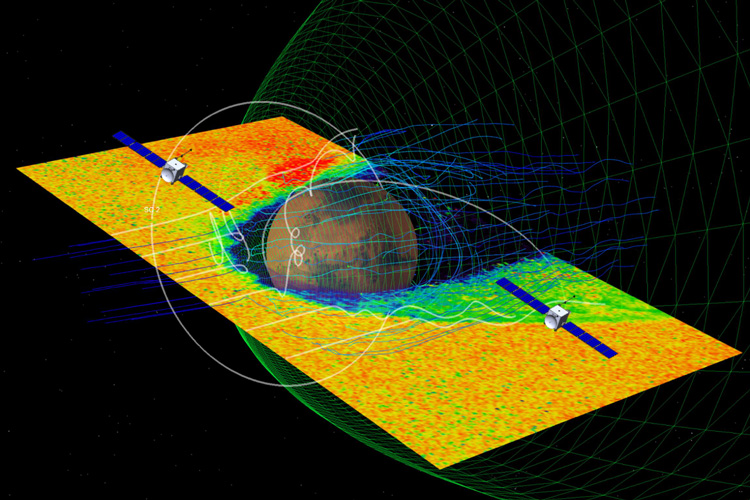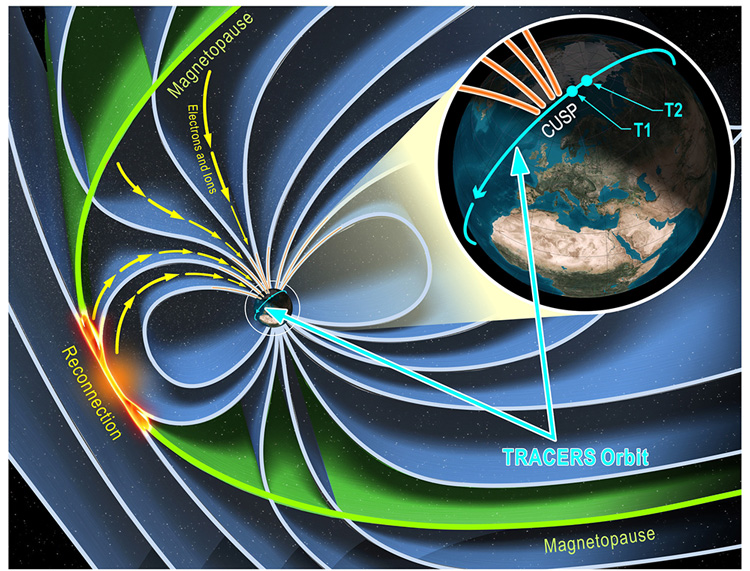Four Berkeley satellites could be exploring Mars and Earth by 2022
Scientists and engineers at the Space Sciences Laboratory are building instruments for two NASA missions, each involving twin satellites
July 9, 2019

An artist’s depiction of the twin TRACERS satellites that will monitor solar wind particles impinging on Earth’s magnetosphere. (Image courtesy of University of Iowa)
If all goes as planned, two teams of scientists and engineers at UC Berkeley’s Space Sciences Laboratory will be sending experiments into orbit around Mars and Earth by the end of 2022, each mission consisting of identical twin satellites.
Last month, NASA announced that a mission comprised of two spacecraft, each carrying an identical suite of experiments, is one of three finalists that may be chosen for launch in three years. Led by Robert Lillis, associate director for planetary science and astrobiology at Berkeley’s Space Sciences Laboratory, the Escape and Plasma Acceleration and Dynamics Explorers (EscaPADE) would orbit Mars and explore how the solar wind strips the atmosphere away from the planet. The twin satellites, each the size of a small mini-bar refrigerator, also would map the planet’s ionosphere, a layer of Mars’ upper atmosphere that could interfere with radio communication between future Mars colonies.
A year from now, NASA will decide whether the mission will go forward, potentially committing up to $55 million dollars to make it happen. More than one of the three finalists may be selected to fly, Lillis said.
In June, NASA gave a final go-ahead for the Tandem Reconnection and Cusp Electrodynamics Reconnaissance Satellites, or TRACERS, mission, which will employ two identical satellites to observe the Earth’s Northern magnetic cusp — a region encircling Earth’s North pole where the planet’s magnetic field lines curve down toward Earth, particularly during violent geomagnetic storms triggered by outbursts from the sun.
Led by Craig Kletzing of the University of Iowa in Iowa City, the TRACERS spacecraft will measure electrical fields with instruments built by UC Berkeley Space Sciences Laboratory (SSL) specialists. The SSL team will be led by John Bonnell, an SSL assistant research physicist. Not including rideshare costs, TRACERS is funded for up to $115 million, of which approximately $13.5 million will come to UC Berkeley.
The two missions — one a go, the other a strong candidate — leverage SSL’s experience in designing, building and operating fleets of satellites to study the magnetic and electric environments of Earth and the moon. The Time History of Events and Macroscale Interactions during Substorms mission, or THEMIS, was a fleet of five satellites launched in 2007 to determine the origin of substorms in Earth’s magnetic environment and the source of shimmer in the colorful auroras.
Two of those THEMIS micro-satellites were dispatched to the moon in 2010 as a separate mission called ARTEMIS (Acceleration, Reconnection, Turbulence, and Electrodynamics of the Moon’s Interaction with the Sun) and are still orbiting the moon studying how its magnetic field is affected by the solar wind. Scientists and engineers from SSL have also built instruments for the two-satellite STEREO mission, which snaps stereo images of the sun. EscaPADE would be the first multi-satellite mission to another planet.
“The selection of two space missions and one major instrument led by SSL researchers in this round shows the great intellectual strength Berkeley has built in space science research,” said Steven Beckwith, SSL director and UC Berkeley professor of astronomy. “It also shows NASA’s trust in SSL to conceive, build, test and fly space satellites, a trust that comes from years of investment in the Laboratory. SSL is now poised to support the next generation of young space scientists at Berkeley who will be leading the missions in the next decade.”
EscaPADE
EscaPADE was selected for a one-year, $8.3 million “concept design” by NASA’s Small Innovative Missions for Planetary Exploration (SIMPLEx), a program that emphasizes small spacecraft — less than 400 pounds — that can conduct stand-alone planetary science missions. The twin spacecraft would share their ride into space with either another NASA mission or with a commercial launch opportunity. EscaPADE would likely fly aboard the same rocket that will launch Psyche, a 2022 mission to explore the mostly-metal asteroid with the same name.

The twin EscaPADE satellites, if approved by NASA, will fly to Mars in 2022 and circle the planet in complementary orbits to sample the hot ionized plasma (cross section in yellow and green) and magnetic fields (blue lines) to understand how Mars’ atmosphere escapes into space. (UC Berkeley image courtesy of Robert Lillis)
“This is exciting, because it is NASA’s attempt to see whether the new space age, what people call the democratization of space — with reduced vehicle cost and new space startups and much more reliable off-the-shelf parts that are a fraction of the price they used to be — will result in a much more cost-effective way to do planetary exploration,” Lillis said. “It is also kind of scary to be one of those guinea pigs.”
Each satellite of the EscaPADE mission would carry instruments built at SSL to measure the flow of high-energy electrons and ionized oxygen and carbon dioxide molecules escaping from Mars, magnetic field detectors built at UCLA and a probe to measure slower or thermal ions built at Embry-Riddle Aeronautical University in Daytona Beach, Florida. With twin satellites, it is possible to measure conditions simultaneously at two places around the planet, allowing scientists to connect plasma conditions at one site to the escaping ion flux at another. Over the course of the mission, the two satellites would change position to map the upper atmosphere and magnetosphere of nearly the entire planet from an altitude of between 200 and 7,000 kilometers.
These data are key to unraveling the climate history of Mars and to determining how and when it lost its atmosphere, which was once dense enough to allow for running water, including rivers, lakes and possibly oceans.
Another goal is to globally sample the ionosphere of Mars, which can interfere with radio communications between people on the surface, between people on the planet and orbiting spacecraft and between Mars colonists and Earth.
“Whether for radio communication or for an eventual GPS system on Mars, you need to understand the structure and variability of the ionosphere to understand how the ionosphere is going to disrupt those signals, affecting both positioning and communications for future Martian settlers,” Lillis said.
TRACERS
TRACERS is one in a long line of NASA missions designed to understand what drives space weather: the winds, storms and electric currents occurring in the space around Earth akin to the weather systems we track in the lower atmosphere. Storms in the upper atmosphere and ionosphere can affect communications on Earth and the safety of astronauts and satellites.

Winds of charged particles from the sun (off-screen to lower left) impinge on Earth’s magnetosphere and enter at points of reconnection somewhere on the magnetopause. Those high-energy particles – electrons and ions – are funneled along magnetic field lines to Earth’s magnetic cusp. In close-up at upper right, the twin TRACERS satellites will fly in single file in a polar orbit to sample particles in the cusp, to determine where and when reconnection happens. (Image courtesy of University of Iowa)
Space weather is driven by a vast outpouring of solar particles from the sun called the solar wind. When these particles reach Earth, they interact with our planet’s magnetic field, creating sometimes destructive electromagnetic storms.
Earth’s magnetic field, the so-called magnetosphere, protects life on the ground from this solar radiation, deflecting it safely around the planet. Yet, some of the energy in that solar wind punches through the magnetopause, the protective shield at its boundary. At these sites, the sun’s magnetic field reconnects and links to Earth’s magnetic field, allowing high-energy solar particles to flow in and spark currents around the globe. Earth’s magnetic field lines funnel these charged particles down to a single spot, the magnetic cusp near Earth’s North pole, eventually creating a halo of colorful auroras around the pole.
The two TRACERS satellites will fly single file in a polar orbit at an altitude of about 600 kilometers, taking it through the cusp several times a day to sample the particles flowing down this drain, in search of those with an energy to indicate they have just come in through a reconnection hole.
“Reconnection occurs somewhere out on the magnetopause itself, 66,000 or 67,000 kilometers above the surface, and we see the effects in the aurora at low altitudes,” Bonnell said. “TRACERS will fly above the aurora but pass through the magnetic field lines that are carrying all these energetic particles in to strike the upper atmosphere.”
TRACERS, he said, will resolve a longstanding question about where reconnection happens at the magnetopause and how the solar wind affects the place and timing, helping NASA better forecast the influx of energetic particles into Earth’s magnetic field that have the potential to disrupt the power grid and satellite communications.